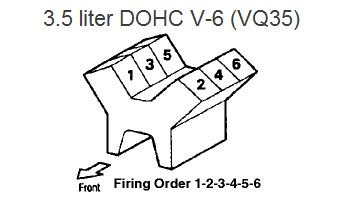The Infiniti G35, powered by Nissan‘s iconic VQ35DE 3.5-liter V6 engine, is a beloved luxury sports sedan and coupe known for its performance, smooth power delivery, and reliability.
At the heart of the engine’s efficient operation lies its firing order, which ensures each cylinder fires in the correct sequence for optimal performance. This guide delves into the Infiniti G35 firing order, its importance, how it works, and tips to maintain it for peak engine performance.

Quick Navigation
What is a Firing Order?
The firing order is the sequence in which an engine’s cylinders ignite their air-fuel mixture during combustion. In the Infiniti G35’s V6 engine, the firing order is 1-2-3-4-5-6.

This sequence ensures that the engine operates smoothly and delivers consistent power. The firing order balances power delivery, reduces vibrations, and maximizes efficiency.
Why the Firing Order is Important
The firing order plays a crucial role in engine performance and reliability. Here’s why it’s vital:
- Engine Balance: Proper sequencing prevents engine vibrations by evenly distributing power strokes.
- Power Delivery: The firing order ensures consistent torque, enabling smooth acceleration.
- Efficiency: Correct firing promotes complete combustion, improving fuel economy and reducing emissions.
- Durability: Balanced operation minimizes wear and tear on engine components, extending their lifespan.
- Smooth Performance: The firing order prevents misfires, ensuring the engine runs reliably and quietly.
If the firing order is disrupted, the engine may exhibit symptoms like rough idling, power loss, and increased fuel consumption.
The Infiniti G35 Firing Order: 1-2-3-4-5-6
The Infiniti G35’s VQ35DE engine uses a firing order of 1-2-3-4-5-6, which follows the sequential numbering of its six cylinders. Here’s how the sequence works:
- Cylinder 1 Fires First: The process begins with Cylinder 1 igniting its air-fuel mixture during the power stroke.
- Cylinder 2 Fires Next: Cylinder 2 ignites, maintaining a smooth progression.
- Cylinder 3 Engages: Cylinder 3 follows, continuing the cycle seamlessly.
- Cylinder 4 Fires: Cylinder 4 takes over, balancing the operation.
- Cylinder 5 Engages: Cylinder 5 fires next, keeping the rhythm intact.
- Cylinder 6 Completes the Cycle: Finally, Cylinder 6 fires, and the sequence repeats.
This firing order evenly spaces the ignition events, ensuring smooth power delivery and optimal engine operation.
How the Firing Order Works in the Infiniti G35 Engine
The Infiniti G35’s V6 engine operates on a four-stroke cycle, with each cylinder undergoing the following stages:
- Intake Stroke: The air-fuel mixture enters the cylinder as the intake valve opens.
- Compression Stroke: The piston compresses the mixture, preparing it for ignition.
- Power Stroke: The spark plug ignites the mixture, driving the piston downward to generate power.
- Exhaust Stroke: The exhaust valve opens, expelling the spent gases.
The firing order ensures these stages are synchronized across all six cylinders. The 1-2-3-4-5-6 sequence is specifically designed for the V6 engine’s layout, balancing power delivery and minimizing vibrations.
Key Components Supporting the Firing Order
Several critical components work together to execute the Infiniti G35’s firing order. These include:
- Crankshaft: Converts the pistons’ up-and-down motion into rotational energy, driving the firing sequence.
- Camshaft: Times the opening and closing of the intake and exhaust valves to align with the firing order.
- Ignition Coil: Sends electrical signals to the spark plugs in the correct sequence to ignite the air-fuel mixture.
- Spark Plugs: Ignite the mixture in each cylinder at precisely the right time.
- Engine Control Unit (ECU): Electronically manages the firing order by controlling ignition timing and fuel delivery.
When these components work together, the firing order ensures the engine operates smoothly and efficiently.
Symptoms of Firing Order Problems
If the firing order is disrupted, the engine may display noticeable symptoms that affect its performance. Common signs of firing order issues include:
- Engine Misfires: Cylinders fail to ignite properly, causing uneven power delivery.
- Rough Idling: The engine may run inconsistently or vibrate excessively at idle.
- Power Loss: An incorrect firing order reduces efficiency, leading to sluggish acceleration.
- Backfiring: Faulty ignition timing may cause combustion gases to ignite in the intake or exhaust system.
- Increased Vibrations: An imbalanced firing sequence creates noticeable engine vibrations.
If these symptoms occur, diagnosing and correcting the firing order promptly can prevent further damage.
How to Verify the Firing Order
To confirm that the Infiniti G35’s firing order is correct, follow these steps:
- Inspect the Ignition Coils: Ensure that each coil is connected to the correct cylinder.
- Check the Spark Plugs: Verify that the spark plugs are clean and properly installed.
- Consult the Service Manual: Refer to the Infiniti G35’s service manual for the correct wiring diagram and firing sequence.
- Use a Diagnostic Tool: A modern diagnostic tool can identify misfires or ignition timing issues.
- Listen for Unusual Noises: Knocking, sputtering, or other irregular sounds may indicate a firing order problem.
Regularly inspecting these components ensures the firing order is maintained and the engine runs efficiently.
Maintaining the Firing Order
Routine maintenance is essential to preserve the Infiniti G35’s firing order and overall engine health. Here are some practical tips:
- Replace Spark Plugs as Needed: Worn or fouled spark plugs can disrupt the firing sequence.
- Inspect Ignition Coils Regularly: Check for cracks, corrosion, or other signs of wear that could interfere with ignition.
- Monitor the ECU: Ensure the ECU is functioning correctly and update the software as necessary.
- Clean the Fuel Injectors: Dirty fuel injectors can cause uneven fuel delivery, impacting combustion timing.
- Use High-Quality Fuel: Clean-burning fuel minimizes carbon buildup, promoting efficient combustion.
Following these practices will help maintain the engine’s reliability and performance.
Can You Modify the Firing Order?
The Infiniti G35’s firing order, 1-2-3-4-5-6, is specifically designed for the VQ35DE engine. Modifying this sequence is not recommended because:
- Imbalance Issues: Altering the firing order can cause excessive vibrations and instability.
- Reduced Efficiency: An incorrect sequence disrupts combustion, leading to power loss and increased fuel consumption.
- Potential Damage: Changes to the firing order can stress engine components, resulting in long-term damage.
For performance improvements, focus on upgrades such as tuning the ECU, optimizing the intake and exhaust systems, or improving the fuel delivery system rather than altering the firing order.
Engines with Similar Firing Orders
Conclusion
The Infiniti G35’s firing order, 1-2-3-4-5-6, is a fundamental part of its engine design. It ensures smooth power delivery, balanced operation, and efficient combustion. By understanding and maintaining the firing order properly, you can keep your G35 performing at its best.
Through regular maintenance, addressing issues promptly, and following best practices, you can preserve the firing order and enjoy the powerful yet refined performance that defines the Infiniti G35. Whether driving daily or pushing your vehicle on the track, a well-maintained firing order ensures your engine runs smoothly and reliably for years to come.

